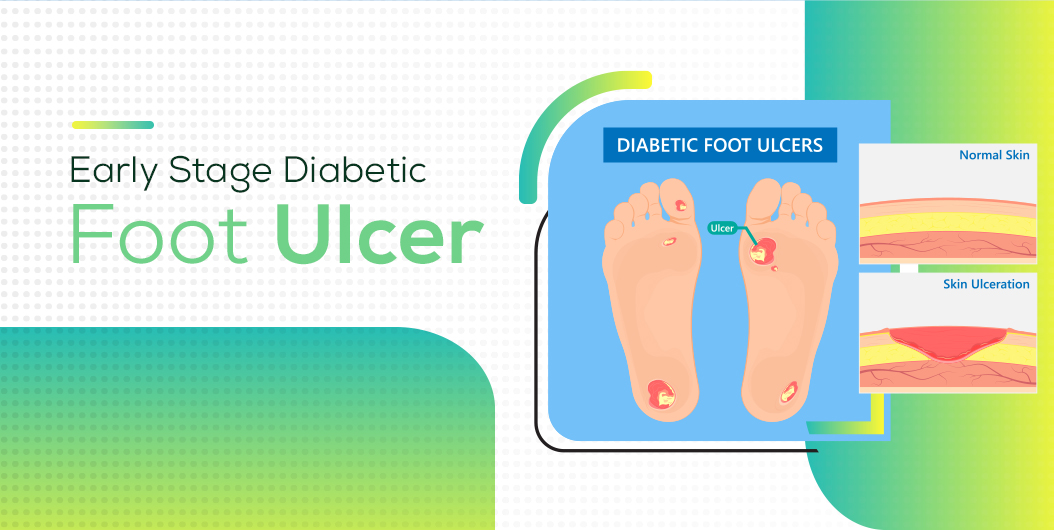Early Stage Diabetic Foot Ulcer
Diabetes is a very common disease affecting 422 million people worldwide, leading to 1.5 million deaths yearly. As the disease progresses, it can cause many complications for the patient, such as heart disease, kidney disease, vision loss, as well as a foot ulcer.
While most people know about the other issues caused by diabetes, they’re unaware of early stage diabetic foot ulcers.
What Is Early Stage Diabetic FootUlcer?
A foot ulcer is one of the first or early signs of diabetes. If you experience any type of drainage from your feet that stains the socks or leaks into your shoes, its recognized as a foot ulcer. Foot ulcers usually happen when your diabetes is not being properly managed, whether due to poor diet, lack of exercise, or no insulin treatment.
This results in ulcers that cause your skin tissues to break down and expose the underneath layers, hence the drainage. The most common spots for early stage diabetic foot ulcers to form are under the big toes and heels, which can go as deep as the bone of your foot.
Early Stage Diabetic Foot Ulcer: Symptoms and Diagnosis
As mentioned above, one of the first signs of early stage diabetic foot ulcer is any type of drainage from your foot that can leak into your socks or shoes. Some other symptoms also include unusual swelling, redness, irritation, or unusual odor from both or one foot.
In some cases, you might not experience any of the above-mentioned issues but notice a visible physical sign known as “black tissue.” This is a very serious sign of an early stage diabetic foot ulcer that forms when healthy blood cells are absent around the area where the ulcer has formed. If the condition goes unnoticed, eschar (black tissue) can progress into partial or complete gangrene, conditions where the tissues completely die due to the infection. This can cause numbness, extreme pain, and odorous discharge.
Keep in mind that signs of early-stage diabetic foot ulcer are not always very obvious. Sometimes, the symptoms can seem like minor aches, similar to being tired after working all day, until the ulcer becomes infected and leads to a serious problem. The best idea here is to seek immediate attention from the doctor if you’re diabetic and experience any type of foot discomfort.
What Do Early Stage Diabetic Foot Ulcers Look Like?
Early stage diabetic foot ulcers are like open wounds in the skin that can be of any shape or size. Some of these shapes and types are more common than others since your diabetic stage and genes can significantly affect making it better or worse. Foot and toe ulcers are usually shaped like a wedge or a crater. However, do keep in mind that they don’t always look like this.
As for the color, early stage diabetic foot ulcers can vary drastically. Some common colors include:
- Yellow
- Red
- Pink
- Grey
- Black
What Are The Different Stages of Diabetic Foot Ulcers?
According to the National Library of Medicine, the diabetic foot ulcer can be categorized into six stages:
- Stage 0: No Open Lesions – Normal foot without any risk factors
- Stage 1: Superficial Ulcer – High-risk foot without penetration to deeper layers
- Stage 2: Deeper Ulcer – Ulcerated foot that has reached tendon, bone, or the joint capsule
- Stage 3: Deeper Tissues – Cellulitic foot with osteomyelitis, abscess, or tendonitis
- Stage 4: Gangrene – Necrotic portion of the forefoot or heel
- Stage 5: Extensive Ganfrenous – Foot that cannot be rescued and leads to amputation
Are There Different Types of Diabetic Foot Ulcers?
While there are many different types of diabetic foot ulcers, three of them are the most commonly found ones that you should know about.
- Neuropathic Ulcers: These types of ulcers occur when the patient has peripheral diabetic neuropathy without ischemia due to peripheral artery disease.
- Ischemic Ulcers: This ulcer occurs when the patient has peripheral artery disease but without the involvement of diabetic peripheral neuropathy.
- Neurpischemic Ulcers: This is when the patient has both, ischemia and peripheral neuropathy that is caused due to peripheral artery disease.
What Causes Early Stage Diabetic Foot Ulcer?
While we’ve briefly mentioned above the potential causes of early stage diabetic foot ulcer, it’s not always the same for all. Sometimes it can be genetic issues that can worsen the situation and lead to a diabetic foot ulcer. However, some common causes of early stage diabetic foot ulcers include
- Poor blood circulation in the feet
Poor blood circulation is a very common issue that diabetic patients may experience. It’s recognized as a vascular disease that prevents the blood from flowing to the feet efficiently, making it even more difficult for the ulcers to reduce or heal.
- Unmanaged and high blood sugar (also known as Hyperglycemia)
Hyperglycemia is a medical condition where your glucose levels remain on the higher side. This greatly hinders the healing process of any infection, even foot ulcers, and might even worsen the situation. Therefore, constantly managing blood sugar levels is critical for diabetic patients. Fighting infections caused by ulcers usually is a challenge for people with Type 2 Diabetes or other similar ailments.
- Severe nerve damage
Nerve damage is a severe condition that doesn’t develop overnight; instead, it’s a long-term effect that can cause permanent loss of feeling in the feet. Nerve damage can be a harrowing and tingly experience that reduces sensitivity in foot pain, making wounds caused by ulcers painless. This can create even bigger issues for the patient since they’ll not know what’s happening on their feet.
- Wounded or irritated feet
If there are any fresh wounds in your feet or irritation, it can also lead to ulcers or worsen it further. The higher the drainage from the wounds, the worse your foot ulcers can get.
What Are The Risks Associated With Early Stage Diabetic Foot Ulcers?
As we mentioned, everyone with diabetes is at risk for foot ulcers since diabetes greatly contributes to this disease. There are multiple reasons how diabetes, along with other factors, can increase your chances of experiencing foot ulcer, such as
- Poor quality shoes or poorly fitted shoes
- Poor foot hygiene (such as not washing your feet regularly or not drying them completely after they’ve been wet)
- Long or improperly trimmed toenails
- High alcohol consumption
- Heart disease
- Kidney disease
- Eye diseases caused due to diabetes
- Obesity
- Use of tobacco (since tobacco inhibits blood circulation)
Diabetic foot ulcer is most common in older men due to the combined effects of impaired pancreatic islet function and insulin resistance along with aging. Sixty percent of these diabetes cases develop neuropathy that ultimately leads to foot ulcers.
How to Treat Early Stage Diabetic Foot Ulcers?
There are many tried and tested ways to eliminate the chances of having early stage diabetic foot ulcers. The first thing to remember is to stay off your feet to prevent extreme pain due to ulcers. This is also known as “off-loading” since it helps reduce and avoid all forms of diabetic foot ulcers. When feet are given additional pressure from excessive walking, it can make ulcers worse by causing infection and expanding to other areas of your foot.
Most doctors recommend wearing certain shoes and items that can help protect your feet and provide relief from ulcer pain, such as:
- Especially designed shoes for diabetic patients
- Casts
- Foot braces
- Compression wraps
- Shoe inserts that prevent calluses and corns
If your foot ulcer has reached a point where it can’t just be treated but has to be removed too, then doctors perform a debridement that removes dead skin or other foreign objects that might have contributed to the ulcer. In case your early stage diabetic foot ulcer has developed into an infection, it’s necessary to get immediate attention since it can be a very serious complication. Most doctors also send the tissue that was surrounding the ulcer to a lab to get it tested, which helps determine which antibiotic can help end it.
When patients develop an infection, doctors suggest multiple ways to help reduce the chances of it expanding further, such as
- Foot baths
- Keeping the ulcer dry with religious dressing changes
- Disinfecting the skin surrounding the ulcer
- Enzyme treatments
- Using dressings containing alginates that prevent bacterial growth
Conclusion
Almost all people with diabetes can develop foot ulcers, especially if you’re not looking after yourself well. However, it’s not inevitable since good foot care can help you combat early stage diabetic foot ulcers from occurring. Various treatments are also available for early stage diabetic foot ulcers, based on the factors that caused it and the severity of the situation. If you’re experiencing any type of foot discomfort or pain, it can be an initial phase of the early stage diabetic foot ulcer. Kindly get in touch with your doctor and get it checked instantly.





